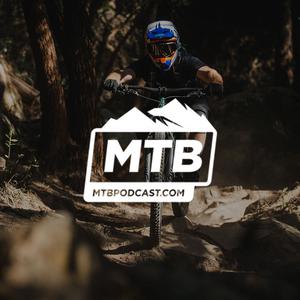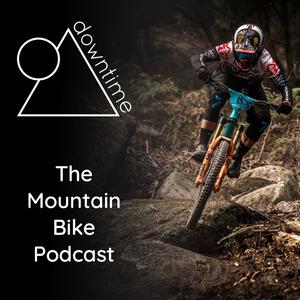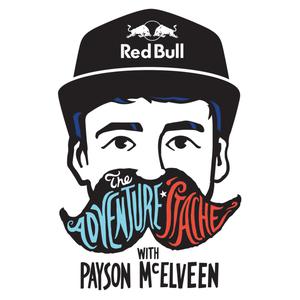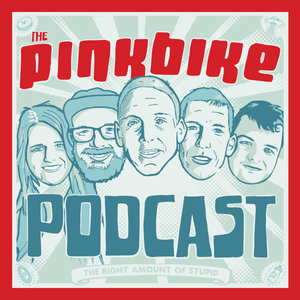
Singletracks Mountain Bike Podcast
Singletracks.com
Podcast host Jeff Barber, Editor-in-Chief at Singletracks.com, aims to inform and inspire with topics and interviews from the mountain bike world. Since 2015, we have been sharing weekly stories from under the helmets of the most inspiring and influential mountain bikers. Join us as we learn from top athletes, product designers, trail builders, coaches, mechanics, artists, and leaders in the mountain biking community. Support this podcast: https://anchor.fm/singletracks/support
- 1 hour 4 minutesHe competed in the first Rampage, and today his bike brand is beloved by riders
Lance Canfield is a mechanical engineer and former professional mountain bike racer who drew his first mountain bike design in 1996. Today his bike brand, Canfield Bikes, sells mountain bikes and components designed and tested in Poncha Springs, Colorado.
- What were downhill bikes like when you began racing in 1994? What did you want to improve about your bike?
- Your first bike design in 1999, the Big Fat Fatty Fat, had 12 inches of travel front and rear. How did that work?
- You competed on some of your own bikes in Red Bull Rampage, including at the first competition ever in 2001. What was it like? How did it compare to today's spectacle?
- Why do you think there aren't many (any?) dedicated freeride bikes on the market today?
- What makes the Canfield Balance Formula (CBF) suspension design different from others on the market?
- Is CBF better suited for certain applications or travel ranges?
- Why are you such a proponent of shorter cranks for mountain biking?
- How has Canfield been affected by industry supply fluctuations over the past few years?
- What's next for Canfield? Which mountain bike developments or trends have you excited about the future?
Visit canfieldbikes.com to see the bikes and components discussed in this episode.
--Keep up with the latest in mountain biking at Singletracks.com and on Instagram @singletracks
17 December 2024, 10:31 am - 48 minutes 42 secondsAfter dominating U23, Riley Amos is ready for the Elites. Here's how he's preparing.
Riley Amos won overall Under 23 World Cup titles in both short track and cross-country this year and finished seventh in the Paris Olympics, the highest an American has ever placed in the event. He is a member of the Trek Factory Racing Team and lives and trains in Durango, Colorado.
- Going into the 2024 season did you expect to win the overall U23 titles in short track and cross-country?
- Do you plan to change your race training or strategy when you move up to Elite next year?
- How much do you focus on nutrition as a part of your training and racing?
- For the last World Cup XC race of the season you rode the Trek Top Fuel which is a FS bike with 120mm of travel front and rear. What made you choose the bike for that course? Were you running a dropper post?
- I read that you joined the Durango DEVO mountain bike program in second grade. Did you participate in any other sports?
- Do you think it's helpful for athletes to specialize in MTB from an early age?
- As a USA Cycling National Team member, have you done much training in Bentonville? How does the riding there compare to Durango?
- Why did you decide to ride the Palisade Plunge as a loop? How did it go?
- In addition to the World Cup circuit, are there other races you're targeting for 2025? Do you have any fun rides planned?
Follow Riley @rj_amos on Instagram.
19 November 2024, 10:06 am - 1 hour 14 minutesLennard Zinn makes the case for chain waxing (and 36-inch wheels, too)
Lennard Zinn is a bike designer and frame builder based in Louisville, Colorado. His shop, Zinn Cycles, offers "a full line of semi-custom and off the shelf bikes for riders from very small to very tall and everyone in-between." He’s also the author of Zinn and the Art of Mountain Bike Maintenance, one of the world’s best-selling guides to mountain bike repair.
In this first-half of our podcast discussion, Zinn talks about drivetrain maintenance, focusing on chains and lubrication. Later in the show we talk about the benefits of big 32-, 36-inch, and 750d bike wheels and designing bikes for riders both tall and small.
Understanding bike chain wear and elongation 0:00
- Chain wear is caused by dirt and oil-based lubricant sticking to the chain, creating a grinding paste that wears down the rollers, bushings, and pins.
- Zinn describes how the chain's inner links are made.
- The chain's flexibility increases as the bushings and plates wear, affecting shifting performance.
- A chain's lateral stiffness is crucial for proper shifting, and a worn chain can cause skipping during shifting.
Chain elongation and its effects 6:46
- Zinn discusses how a chain's elongation affects its performance, particularly when the distance between rollers exceeds the half-inch standard.
- He explains that a worn chain can misshape the cassette's teeth, leading to skipping and poor shifting.
- Chain checkers can be used to ensure the chain's length is within spec to prevent cassette wear.
Lubrication and its impact on chain wear 22:35
- Zinn explains that a dry chain will wear faster due to friction, while lubrication helps reduce wear but can attract dirt.
- He discusses the differences between factory lube and other lubricants, noting that factory lube is designed for machinery, not for low friction on the bike.
- Zinn recommends using a cleaner to remove factory lube before applying chain lube.
- He introduces the concept of chain waxing, which involves immersing the chain in molten wax to create a low-friction, clean-running chain.
- Zinn shares the benefits of chain waxing, including reduced noise, lower friction, and longer chain life.
Chain waxing process and benefits 35:43
- Zinn describes the process of chain waxing, including the need for a clean jar of mineral spirits and denatured alcohol for cleaning the chain.
- He mentions the cost-effectiveness of chain waxing compared to replacing chains frequently.
Wheel sizes and their applications 1:03:20
- Zinn discusses the advantages of larger wheels for tall riders like 32-, 36-inch, and 750d wheels, noting that 32-inch wheels can make a bike look proportionally sized.
- He explains the challenges of using larger wheels, such as increased weight and the lack of suspension forks.
- Zinn mentions the development of new carbon rims and tires for larger wheels, which could improve their performance and weight.
- Barber asks about the feasibility of using suspension forks with larger wheels, and Zinn confirms that rigid forks are the only option.
Challenges in designing bikes for small riders 1:16:58
- Barber asks about the challenges of scaling bikes for smaller riders, and Zinn explains the limitations due to the need for certain components.
- Zinn highlights the importance of proportional design, where larger wheels can make a bike look more proportionate for tall riders.
- He discusses the ergonomic issues for small riders, such as wider Q-factors and shorter steerer tubes on forks.
- Zinn mentions the UCI's weight limit in road racing as an example of how smaller riders are often disadvantaged.
Modern trends in bike design and their impact 1:18:46
- Zinn highlights the shortening of steerer tubes on forks which can be a problem for taller riders.
- He discusses the trend of wider rear ends in modern bikes, which can be detrimental to smaller riders due to increased Q-factor.
Find out more about the chain waxing service and bikes discussed in this episode at zinncycles.com.
1 October 2024, 9:42 am - 44 minutes 7 secondsCraig Calfee designed his carbon mountain bike to be N minus 1
Craig Calfee is an innovative bike builder and the founder of Calfee Design. Calfee was an early adopter of carbon fiber for bike frames in 1987, and brand's Tetra road bike is said to have been in production longer than any other carbon bike. You might also recognize his work with Bamboo bike frames, which he began in 1995.
- How did you get your start building bikes?
- What did people think about the carbon bike frame you debuted at Interbike in 1989? Were there concerns that carbon frames were untested?
- Are you still doing carbon frame production in the US?
- How does carbon frame repair work?
- Your mountain bike, the Cephal, utilizes a system called Quick Tune Steering. What's the idea behind this feature?
- The Cephal is a hardtail with "leaf spring chain stays." What are the benefits to having flexible chain stays?
- Were you surprised about your bamboo bike frame prototype?
- From a practical standpoint, is bamboo a good material for building bike frames?
- Why do you offer so many different tandem bikes? What are the challenges associated with building a tandem, particularly a mountain tandem?
- How does your electric pedal assist retrofit service work?
- What kind of work have you done on adaptive bikes?
- What's next on the horizon for Calfee Design?
Connect with Calfee Design and learn more at calfeedesign.com.
Visit singletracks.com for a complete transcript of this episode.
--Keep up with the latest in mountain biking at Singletracks.com and on Instagram @singletracks
17 September 2024, 9:15 am - 42 minutes 33 secondsHow hip packs and frame bags are made, with Bullmoose Softgoods
Wes Holland is the owner of Bullmoose Softgoods where he designs and produces one-of-a-kind bags for cycling and adventuring. Bullmoose is based in Summerville, Massachusetts and currently offers handlebar and frame bags plus hip packs and accessories.
- What came first for you: bikes or bags?
- What kind of riding do you like to do? What is the riding scene like in Boston?
- There are a lot of hip packs and handlebar bags out there, so why make your own?
- What types of materials are you working with?
- What's your shop setup like?
- Your hip packs aren't cheap, with prices starting at $130. What makes bags like this so expensive?
- What's the trickiest part about making a bag for biking? How long does it take to make a frame bag, for example?
- Have you had any failures when testing new designs?
- With accessory mounts becoming more common across all types of bikes, does this make fitting or attaching bags easier for you as a bag maker?
- What's in your hip pack?
- Do you have new products or projects on the horizon?
Check out Wes's work at bullmoosesoftgoods.com.
An auto-edited summary of our conversation is available at Singletracks.com.
20 August 2024, 9:14 am - 1 hour 3 minutesMTB trail quality is "about to ramp up on the hockey stick"
Greg Mazu is the self-described "Chief Dreamer" behind Backslope Tools, a company that designs and sells tools for trail building and forest maintenance. He's also the founder of Singletrack Trails, a trail building company that recently finished its last project after 20 years in the business.
- When did you build your first trail?
- How did you get into professional trail building?
- What motivated you to start Tools for Trails, and later Backslope tools?
- Where are Backslope tools manufactured?
- If you could only have one tool to use for building a trail, what would it be?
- Some riders say they prefer natural trails to machine-built ones. Do you have a preference for riding machine- or hand-built trails? Can a machine-built trail be built to feel like a natural or hand-built trail, or vice versa?
- Singletrack trails was involved in some iconic projects over the years in places like 18 Road and Lunch Loops in Fruita, Black Mountain in North Carolina, Palisade Plunge in Colorado, and Handcut Hollow in Bentonville. Which trail building projects are you most proud of?
- What are some favorite trails you weren't involved in building?
- What are some of the challenges the trail building industry is facing in meeting increased demand for trails?
- Have we reached a peak in terms of trail quality, or is there room for further growth and improvement? What are some of the latest, or upcoming innovations riders can look forward to?
See the tools we talked about at backslopetools.com and follow @gregmazu on Instagram.
--Keep up with the latest in mountain biking at Singletracks.com and on Instagram @singletracks
23 July 2024, 9:47 am - 55 minutes 14 secondsHow do you set an FKT on Kokopelli's Trail? Stop trying to be perfect, says Hannah Otto.
Hannah Otto recently became the fastest known woman to ride the 137-mile-long Kokopelli's trail from Moab, Utah to Loma, Colorado, besting the previous fastest known time by over an hour. In addition to racing gravel and mountain bikes, she's also a certified athletic trainer.
- How do you feel now that you can finally talk about your accomplishment? Were you worried someone else would make an FKT attempt between then and now?
- In October you made your first attempt, but it didn't work out. What happened.
- What did you do differently the second time around?
- What was your bike setup? What did you eat?
- How do you pace yourself for a ride like this?
- Do you think this FKT rules that should be updated or clarified to allow film crews as long as they don't offer any assistance?
- How much of a role does luck play in mountain bike racing, versus skill and fitness?
- Do individual time trials also make you a faster racer in more traditional events, or is this a specialized skill set?
- What's next? Do you have any more FKT attempts on the horizon?
View the Kokopelli Strong film on Youtube and follow @hannah_finchamp on Instagram. Photo credit: @mahkus.g.
--Keep up with the latest in mountain biking at Singletracks.com and on Instagram @singletracks
16 July 2024, 9:33 am - 1 hour 1 minuteIs carbon better than aluminum for MTB frames? It depends on how you use it!
Chuck Teixeira is a Senior Advanced Concept Engineer at Specialized where he's been involved in countless projects from mountain to road, and from bikes to components. Prior to joining Specialized in 2011, Chuck spent 28 years at Easton-Bell where he was the director of R&D.
- How did you end up in the bike industry?
- How does the Smartweld tech used on the new Specialized Chisel mountain bike frame work, and what makes it different from traditional aluminum frame welding? Why haven't we seen this on more Specialized mountain bikes?
- Are mountain bikers still overlooking aluminum in favor of carbon frames?
- How did you and the Roval team come upon the anti pinch flat bead-wall design?
- When it comes to mountain bike rims, is there a clear winner when it comes to material choice, carbon vs. aluminum?
- What are some of your favorite mountain bike products or designs that you've been involved with over the years?
- How have you recovered from the Santa Cruz wildfire that claimed your house in 2020?
- As someone who has lived and breathed bicycles since the 1980s, is there anything that surprises you today? What are you working on right now that has you stoked?
--Keep up with the latest in mountain biking at Singletracks.com and on Instagram @singletracks
9 July 2024, 12:24 pm - 40 minutes 57 secondsThe Case for High Pivot MTB Design, and How it Works
Colin Ryan is a Senior Development Engineer at Norco and was involved in the design of the latest Norco Optic trail bike which features a high-pivot design. Prior to joining Norco he worked at General Kinetics testing and developing shock absorbers for military and construction equipment.
- At a basic level, what problem does a high pivot design solve? Is there a certain type of riding that benefits from having a high pivot?
- What are the drawbacks to the design?
- Does a high pivot design improve longevity for certain components?
- With less chain wrap on the crank, are dropped chains an issue with a high pivot setup?
- How does the placement of the idler pulley affect performance? What about the number of teeth on the idler cog?
- Did moving from a traditional setup to high-pivot change the ride feel of the Norco Optic significantly?
- The decision to use a high pivot on a short, 125mm travel bike is a controversial one. Why do you think that is?
- The latest Optic is said to be lighter than the previous version. How much weight does the idler hardware add, and how did you manage to make the bike lighter overall?
- How is the intended use of the Optic different from the Fluid which has a very similar amount of travel (140/130mm)?
- What's next for high pivot mountain bike designs?
Cover photo: Matt Miller.
See the Norco Optic and other high pivot bikes from the brand at norco.com.
--Keep up with the latest in mountain biking at Singletracks.com and on Instagram @singletracks
18 June 2024, 9:19 am - 37 minutes 16 secondsThis Mental Health Counselor is Using Mountain Biking as Adventure Therapy
Sara Hunter is a Licensed Clinical Mental Health Counselor in the state of North Carolina and a PMBIA Level 1 Mountain Bike Instructor. Her practice includes individual and couples counseling services plus mountain bike therapy and counseling for athletes and outdoor instructors. She's also a Specialized USA Ambassador.
- What led you to get into counseling?
- Does everyone benefit from spending time outdoors, or do you think some of us are just wired that way?
- What is Adventure Therapy? What is the idea behind it?
- Is there such a thing as spending too much time outdoors?
- As someone who works to address conflicts between individuals, do you have any ideas about how people can share the trail?
- Sometimes I get frustrated on group rides when the rider in front of me gets in my way. Is there a way to re-frame this?
- Unsolicited advice — about how to ride, or fix a bike — generally comes from a good place of wanting to help, but is there a better approach?
- What are some ways I can be more supportive of someone who is having a tough or bad ride?
- How can counseling help riders recover after an injury?
- Do you have any tips for calming nerves on race day, or even before a challenging ride?
- Do you have tips for reducing the risk of loneliness for athletes or travelers living the van life?
- What's the biggest benefit you get from mountain biking personally?
Connect with Sara and her practice at sarahuntercounseling.com and find about upcoming workshops at her Instagram account, @mindfulmountainbike.
11 June 2024, 9:21 am - 45 minutes 48 secondsHow to Fuel for Mountain Biking, According to a Registered Dietitian
Alex Larson is a registered dietitian and multi-sport athlete who helps endurance athletes optimize nutrition and performance. She's written multiple nutrition guides and offers customized nutrition coaching services to athletes around the world.
- Do athleticism and nutrition go hand in hand? Are athletes generally healthy eaters by nature?
- What is a "flexible eating style"? Are restrictive diets sometimes harmful?
- How does pre-race fueling work?
- Is nutrition drastically different for training vs. racing?
- Is it more challenging for athletes to maintain a healthy gut than non-athletes?
- What types of things can cause gut issues for athletes during a workout?
- Are there signs that nutrition is holding us back from fitness gains?
- What have you learned about nutrition from your own training?
- With summer approaching, should athletes adjust their diet based on the season?
- Does an individual's nutrition plan look different for different sports?
- Do you recommend an app for tracking daily nutrition or a food journal?
- If I eat the wrong thing after a race, is that going to have a big effect on my future performance?
- What's one simple step mountain bikers can take to improve their nutrition?
For additional nutrition resources and to connect with Alex, visit alexlarsonnutrition.com.
--Keep up with the latest in mountain biking at Singletracks.com and on Instagram @singletracks
4 June 2024, 9:08 am - More Episodes? Get the App
Your feedback is valuable to us. Should you encounter any bugs, glitches, lack of functionality or other problems, please email us on [email protected] or join Moon.FM Telegram Group where you can talk directly to the dev team who are happy to answer any queries.
 MTB Podcast
MTB Podcast
 The Inside Line Podcast - Vital MTB
The Inside Line Podcast - Vital MTB
 Downtime - The Mountain Bike Podcast
Downtime - The Mountain Bike Podcast
 The Adventure Stache
The Adventure Stache
 The BikeRadar Podcast
The BikeRadar Podcast
 The Pinkbike Podcast
The Pinkbike Podcast